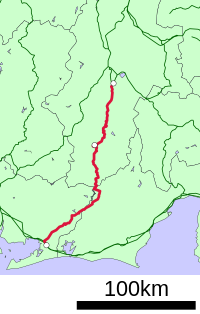| Iida Line | |||
|---|---|---|---|
 JR Central 313 Series train | |||
| Overview | |||
| Owner | |||
| Locale | Aichi, Shizuoka, Nagano prefectures | ||
| Termini | |||
| Stations | 94 | ||
| Service | |||
| Type | Heavy rail | ||
| History | |||
| Opened | 15 July 1897 | ||
| Last extension | 20 August 1937 | ||
| Technical | |||
| Line length | 195.7 km (121.6 mi) | ||
| Track gauge | 1,067 mm (3 ft 6 in) | ||
| Electrification | 1,500 V DC (overhead catenary) | ||
| Operating speed | 85 km/h (53 mph) (maximum) 40–50 km/h (25–31 mph) (curves) 25–35 km/h (16–22 mph) (diverging junctions) | ||
| Train protection system | ATS-PT | ||
| Maximum incline | 4.0% | ||
| |||
The Iida Line (飯田線, Iida-sen) is a Japanese railway line connecting Toyohashi Station in Toyohashi, Aichi with Tatsuno Station in Tatsuno, Nagano, operated by Central Japan Railway Company (JR Central). The line links eastern Aichi Prefecture and southern Nagano Prefecture through northwestern Shizuoka Prefecture. It goes through steep mountains as well as cities such as Iida and Ina. The line was originally of four different private railway lines, the first of which opened in 1897.
The line has an unusually high number of so-called Hikyō stations, or hikyo-eki, which have since lost their nearby communities due to depopulation.[1] There are 94 such stations along the route.[1] The line has been described as the "holy land for those who love touring hikyo-eki".[1] The phrase was coined in 1999 by Takanobu Ushiyama and friends, for railroad stations that are isolated and little used.[1]
Traveling the entire length of the 195.7 km (121.6 mi) line by local trains takes six hours.[1]
- ^ a b c d e KOIZUMI, SHINICHI (2 August 2018). "Remote stations have great views if you know where to look:The Asahi Shimbun". The Asahi Shimbun. Archived from the original on 27 February 2019. Retrieved 11 August 2018.
